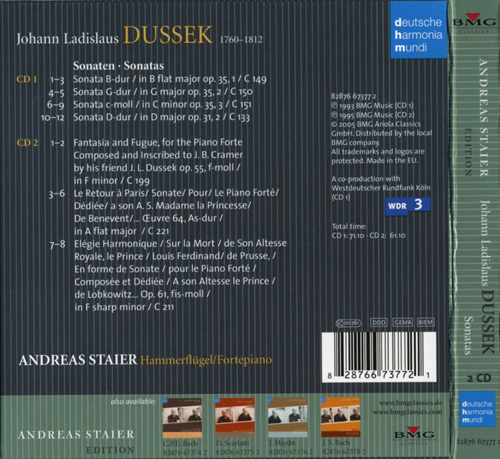Johann Ladislaus Dussek (1760–1812) was regarded by his contemporaries as one of the foremost keyboard performers and composers of his age. Over a span of three decades, Dussek completed nearly 300 compositions, most of which involve a keyboard instrument. The sonata as a genre holds a special position in his overall oeuvre: keyboard sonatas were among his first published pieces in the early 1780s, and the sonata Op.77 in F minor was to be his last work before his death in 1812.
This set is the result of an extensive recording project using the combined resources of eight excellent fortepianists to produce the first comprehensive recording of Dussek’s keyboard sonatas on period instruments. Listeners are invited to take a journey through the brilliant, harmonically beautiful and expressive music of one of the most fascinating composers at the threshold of early Romanticism. While in modern times piano building has been largely standardised, 18th-century instruments were very personal works of art, and their construction differed from town to town and from builder to builder, and even within one builder’s output. The distance between cities as far apart as London and Vienna resulted in two distinct schools of piano building: the “English” and the “Viennese.”
The formidable array of both English and Viennese fortepianos played on this recording (see info below) provides listeners with a parallel journey, alongside through Dussek’s music, exploring the great tonal variety that existed amongst fortepianos in the composer’s day, with each instrument’s unique qualities matched to the differing characters of Dussek’s works.
Other information:
- Recordings date from 2017–2021
- Period instruments used include fortepianos by Longman, Clementi & Co. (London, 1797), (London, 1798) & (London, 1798/9); Chris Maene (Ruiselede, 2003, after Longman–Clementi, London, 1799), (Ruiselede, 2010, after Anton Walter); Robert Brown (Oberndorf, 2009, after Michael Rosenberger, Vienna, c.1810); John Broadwood & Son (London, 1804); Paul McNulty (after Anton Walter, 1792); Thomas & Barbara Wolf (Washington DC, 1983, after Johann Schanz, c.1800); anonymous Viennese 5-octave (c.1795/1800)
- Booklet in English contains a profile of the composer by Olga Witthauer and extensive liner notes on each of the discs, written by several of the performers.
- For the first time all in one 10-CD box: the complete Piano Sonatas and Sonatinas by Johann Ladislaus Dussek!
- Johann Ladislaus Dussek (1760-1812) was born in rural Bohemia. He led a restless life, travelling Europe as a keyboard virtuoso and settling in several European capitals, notably Paris and London, where he became a fashionable pianist and teacher.
- Dussek’s style is rich, harmonically expressive and pianistically challenging, Classicism on the brink of Early Romanticism.
- Played by 10 eminent and foremost pianists playing period instruments: Bart van Oort, Piet Kuijken, Alexei Lubimov, Tuija Hakkila, Wolfgang Brünner, Viviana Sofronitsky, Zvi Meniker,
- Ursula Dütschler and Petra Somlai, all of them experts in the field of historically informed performance practice.
- The single CD issued previously has received numerous excellent reviews in the press: Fanfare: ‘Bart van Oort, playing on a late 18th-century Longman Clementi instrument, serves up vital, energetic performances that draw the most from the music… Strongly recommended.’, ‘Uniformly adept performances… that illuminate the music’s characteristic disruptions without over-emphasizing them, and that capture the music’s emotional character (or, more accurately, characters) with impressive conviction.’ (Volume 4, 95604) Brilliantclassics
Tracklist :
CD01 - Op.10 and Op.31 (61:07)
CD02 - Op.25 and Op.39 (54:35)
CD03 - Op.44 and Op.77 (62:35)
CD04 - Op.5, 24, 43, 61 (61:22)
CD05 - Op.18 and Op.45 (65:01)
CD06 - Op.9 and Op.75 no.3 (79:12)
CD07 - Op.47 and Op.64 (59:48)
CD08 - Op.14 and Sonate in G (56:29)
CD09 - Op.35 and Op.69 no.3 (84:40)
CD10 - Sonatinas Op.32 and Op.20 (77:00)








.jpg)








